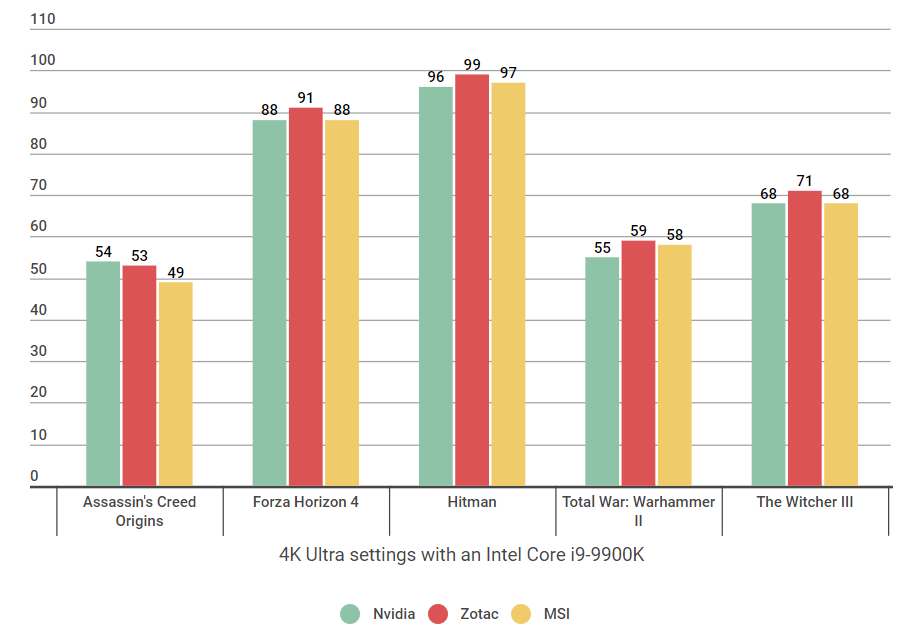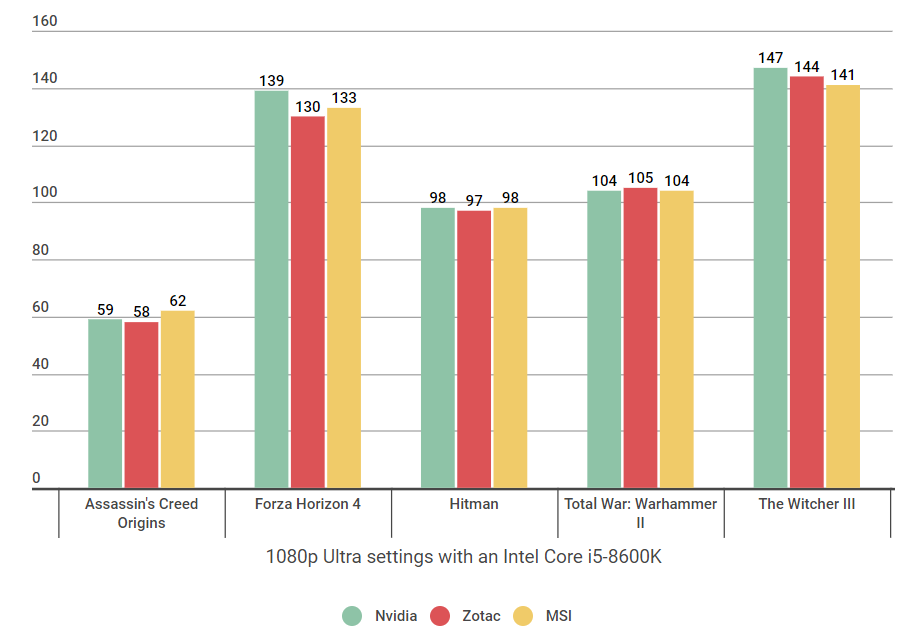
Despite costing an arm, a leg plus a few kidneys, Nvidia’s GeForce RTX 2080Ti has shortly established itself because the best graphics card on the planet. If you’ve ever wished to play games in 4K on the highest settings with out the faff of gaffer-taping two GPUs collectively through SLI bridges and whatnot, the RTX 2080Ti is by far and away one of the best single card answer for 4K perfection chasers. As with any graphics card buy, nonetheless, the large drawback dealing with potential RTX 2080Ti house owners is which of the various 1000’s of this specific card is definitely one of the best one to purchase?
To assist shed a bit of sunshine on the problem, I’ve been pitting a bunch of various RTX 2080Tis towards one another to see which one’s greatest, together with MSI’s GeForce RTX 2080Ti Duke OC, Zotac’s GeForce RTX 2080Ti AMP! Edition and Nvidia’s personal Founders Edition. Of course, that is nonetheless only a small fraction of all the assorted 2080Tis on the market in the intervening time, and I’ll do my greatest so as to add extra playing cards to this large graphical showdown after I can. For now, although, it’s a three-horse race between Nvidia, Zotac and MSI. Come and learn the way they bought on by the medium of some graphs.
But first, some specs. As you’d count on, all three playing cards include the identical 11GB of GDDR6 reminiscence and 4352 CUDA cores, however the important thing distinction between them (other than their general measurement and varied bits of cooling equipment) is how these cores have been clocked. Nvidia’s reference specification for the RTX 2080Ti, as an example, has a base clock pace of 1350MHz and a lift clock pace of 1545MHz. All three have caught with the previous, however Nvidia’s Founders Edition pushes the latter as much as 1635MHz, whereas the MSI and Zotac go even additional to 1665MHz.
That’s the principle cause why so typically you’ll see at the least £100-200 (if no more) separating the most cost effective and costliest GPUs of any given card sort – the quicker a card can doubtlessly run, the higher efficiency you’ll theoretically get from it. Cooling additionally performs a giant position in how a lot playing cards price as properly. Just like in actual life, sizzling parts typically equals sad parts, and sad parts are more likely to begin throwing a wobbly and develop into a little bit of a bottleneck than those that can maintain their cool. As a outcome, it’s no shock that MSI and Zotac’s three-fan jobs price much more than Nvidia’s dual-fan version.
The draw back is that each of this stuff can typically make playing cards extra power-hungry than others, however for the needs of at this time’s check I’ll be specializing in efficiency and efficiency alone. So how does MSI’s £1250 / $1220 (however at present out of inventory actually in every single place) Duke OC evaluate to Zotac’s £1370 / $1500 AMP and Nvidia’s £1099 / $1199 Founders Edition? Behold.
RTX 2080Ti 4K efficiency
With the help of Assassin’s Creed Odyssey, Forza Horizon 4, Hitman, Total War: Warhammer II and The Witcher III, I ran my two numerous exams: one with an Intel Core i5-8600Okay and 16GB of RAM in my PC, and one other with Intel’s new Core i9-9900Okay (a evaluate of which can be accessible early subsequent week) and the identical 16GB of RAM. As you might bear in mind, I had an inkling that my Core i5 was inflicting some bottleneck issues after I first took a take a look at the RTX 2080Ti, notably at decrease resolutions, and testing it with the Core i9 confirmed these suspicions had been certainly appropriate, typically displaying positive aspects of virtually 20fps.
That stated, I discovered the precise distinction between all three playing cards was surprisingly small. At 4K utilizing every game’s highest high quality settings, Nvidia’s Founders Edition was constantly the quicker card of the three when paired with my Core i5 CPU, which is fairly damning for the opposite two when it prices a lot much less. Even when Zotac and MSI’s efforts did handle to sneak out in entrance, the quantity you’re truly gaining actually doesn’t really feel like £150-300 / $120-300 value of additional efficiency.
Admittedly, a unique image emerged after I retested every card with the Core i9-9900Okay. Here, it was Zotac’s AMP! Edition which proved to be the quickest card (besides in Assassin’s Creed Odyssey the place Nvidia’s model nonetheless had the very slight edge), however the level stays that they’re all fairly rattling shut to one another.
Of course, it’s extremely doable that it’s now my motherboard (the admittedly low-down Asus Prime Z370-P) performing because the bottleneck as an alternative of the CPU (and I’ll be re-testing once more with certainly one of Intel’s new Z390 chipsets very shortly), however finally I’m not satisfied a superior motherboard is immediately going to make one card bounce up considerably increased than all of the others.

With Intel’s new Core i9, there are positively some positive aspects to be discovered, however other than Assassin’s Creed Odyssey, they’re all fairly tiny.
RTX 2080Ti 1440p efficiency
Things began wanting extra promising after I dropped the decision right down to 2560×1440. Admittedly, this isn’t actually the decision these playing cards are concentrating on, however these with excessive refresh fee screens ought to nonetheless get quite a bit out of them right here. As you may see from the outcomes under, all games besides Assassin’s Creed Odyssey had been pushing properly into 90fps and above territory, permitting for top body fee gaming with completely zero compromise on general high quality.
However, aside from Forza Horizon 4 (and at a push Total War: Warhammer II), I’m undecided a achieve of 2-Three frames is admittedly value spending an additional £150-300 / $120-300 on – at the least if you happen to’ve bought a Core i5 in your PC.

At 1440p, the Core i5 is unquestionably holding all three playing cards again in comparison with their Core i9 outcomes, however there’s nonetheless not £200s value of distinction between all of them.
Switch over to a Core i9, nonetheless, and we begin to see some bigger gaps starting to emerge, and never simply in comparison with what I managed with a Core i5. Assassin’s Creed Odyssey shot up in pace at this decision, as did Hitman and Total War: Warhammer II, proving the Core i5 was positively holding a few of my earlier outcomes again from their true potential.
Once once more, although, you’re solely actually a distinction of 5fps throughout every particular person card with this CPU, which to me merely isn’t value the additional expense. Yes, Zotac’s card proved as soon as extra to be the superior card of the three normally, but when I had been in addition up Forza Horizon 4, for instance, I reckon the Nvidia’s 114fps goes to feel and appear simply as clean because the Zotac’s 119fps to my frame-addled eye balls, so I would as properly save myself £300 / $300 within the course of and perhaps look into placing it towards a greater CPU as an alternative.

The Core i9 positively relieves a number of the earlier bottlenecking I used to be experiencing at this decision, however as soon as once more the hole between all three playing cards with this spec is positively minuscule.
RTX 2080 Ti 1080p efficiency
It must be obvious by now that there’s actually not a complete load of distinction between these three RTX 2080Ti playing cards, however holy moley does it develop into much more apparent at 1920×1080. Much like I discovered in my preliminary RTX 2080Ti evaluate, my 1080p outcomes bore a stunning equally to the speeds I bought at 1440p with my Core i5, notably within the case of Hitman and Assassin’s Creed Odyssey the place all three playing cards produced virtually similar body charges to one another throughout each resolutions. There was somewhat extra variation in Forza Horizon Four and The Witcher III, however satirically it was Nvidia’s card that got here out on prime, not its dearer rivals.
But good gravy, simply take a look at the state of those Core i9 outcomes. As hinted at above, this might be the fault of my motherboard at this level, however come on. This is simply getting foolish.
In conclusion, if you happen to occur to have a spare grand mendacity round for an RTX 2080Ti, you’re in all probability going to be simply as properly catered for with Nvidia’s considerably cheaper Founders Edition than you might be with dearer ones with additional bells and whistles – confirming my long-held perception that, clock speeds and variety of followers be damned, the most cost effective model of no matter graphics card you’re seeking to purchase is nearly actually going to offer simply nearly as good an expertise as one which prices half as a lot once more.
This idea gained’t apply to each graphics card, in fact, and people with souped up, water-cooled mega rigs will in all probability scoff on the concept of even trying to ship a verdict on such a card with solely a piddly Asus Prime Z370-P motherboard to point out for it. However, the very fact stays that, even with probably the most premium, high-end PC cash should buy, it’s extremely seemingly you’re nonetheless solely a marginal body fee achieve between playing cards akin to these (which let me remind you once more are £300 / $300 aside in value), which to me, simply isn’t value it.
Yes, there can be some individuals for whom technical excellence is absolutely the most necessary factor on the complete planet, making them really feel protected within the data their card is healthier than everybody else’s. For these after a peerless subjective expertise, alternatively, there are some fairly hefty financial savings available.






